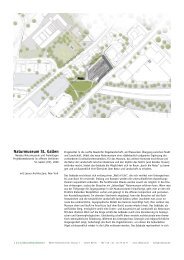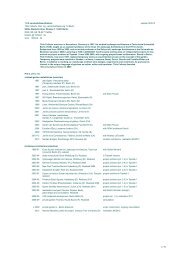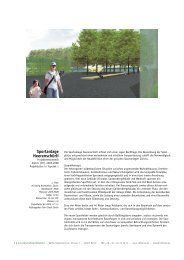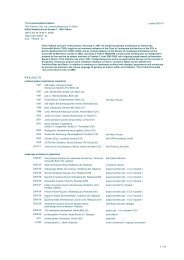Garden Bridges - 100land Landschaftsarchitektur - Thilo Folkerts
Garden Bridges - 100land Landschaftsarchitektur - Thilo Folkerts
Garden Bridges - 100land Landschaftsarchitektur - Thilo Folkerts
You also want an ePaper? Increase the reach of your titles
YUMPU automatically turns print PDFs into web optimized ePapers that Google loves.
<strong>Garden</strong> <strong>Bridges</strong><br />
urban installation<br />
commissioned proposal<br />
Parckdesign 2012<br />
Brussels (B)<br />
06-09/2012<br />
www.parckdesign2012.be<br />
team:<br />
Christine Guérard<br />
Almuth Bennett<br />
curatorial assistance:<br />
Elise François (Architecture<br />
Workroom Brussels)<br />
scaffolding:<br />
Altrad AnD, Verrebroek (B)<br />
General context - The event ‘Parckdesign 2012’ aims at reflecting the aesthetic, social, urbanistic<br />
and ecologic value of terrains vagues. At core this ambition is about public accessibility<br />
- factual, intellectual, or emotional - to these open spaces. The interventions within the framework<br />
of the event can in this sense not establish a newly designed landscape, but open new<br />
paths of perception. The projects can be part of a scrutiny of the existing „working landscape“<br />
of the space.<br />
Situation - The situation of lot 8 is characterized by the bridge across Charleroi Canal. The<br />
project location in fact consists of five sites that are interstitial spaces between or next to<br />
the staircases connecting the bridge level with the canal level. The staircases are built in a<br />
historicizing, heavy stone construction. Albeit meant to facilitate connection and interchange,<br />
they are in themselves impenetrable, unapproachable objects. Due to their current ‚freestanding‘<br />
urban context, their hermetic character becomes even more obvious. Originally conceived as<br />
decorative additions to the stairs, the interstitial spaces are dis- and misused, the same lack of<br />
attention applies to the adjacent brownfields. The stairs‘ heavy representational gesture goes<br />
amiss in an unbound urban context that consists of vaguely maintained remnant ornamental<br />
shrubs, ruderal vegetation and a heavy mass of refuse and urban debris.<br />
Project - The project aims to bridge the stairs with its immediate surrounding, confronting and<br />
activating also these spaces. As a set of instruments for access, stay and observation, a number<br />
of scaffolding structures extend the functionality of the staircase. The scaffolding interventions<br />
(re)bridge the staircases on both sides of the canal. The dimensions of the interventions vary<br />
and adapt to the situation: the largest structure leads into the ruderal field behind the stairs<br />
next to Metro station Delacroix, creating the possibility of a lofty walk on a thin scaffolding<br />
platform. A ladder-like structure leading to the staircase‘s raised planting bed at Quai Fernand<br />
1 0 0 <strong>Landschaftsarchitektur</strong> - Käthe Niederkirchner Strasse 7 - 10407 Berlin - t/f +49.30.46794671 - www.<strong>100land</strong>.de - mail@<strong>100land</strong>.de
Desmets is possibly more a suggestion of access, than an opportunity to be taken by every<br />
visitor. A scaffolding balcony at the Southeastern stairs marks the garden interventions in a<br />
long vista from Rue Ropsy Chaudron, sharpening the view for the cohesive context of the sites<br />
around the bridge.<br />
The project strategy points at enabling the individual discovery of the aesthetic value of empty<br />
spaces. It also enhances the aspect of transition as part of nature (and urban life). Essentially,<br />
scaffolding creates structure and opportunity in a „construction“ period. It also points to the<br />
future, as a promise of something happening - mostly a hopeful outlook, as construction conventionally<br />
brings improvements. The use of scaffolding material thus answers at once to the<br />
temporary character of the installation project (and the Parckdesign event). It also comments<br />
on the constructive, active character of public open space.<br />
The five sites themselves are not re-designed,<br />
but retain their raw, ruderal character. Where<br />
the existing soil is heavily compacted or where<br />
a (slight) disturbance has to happen for the<br />
construction of the scaffolding, the ground will<br />
be loosened, prepared, sown with a seed mixture<br />
of spices and left for ruderal growth for the rest<br />
of the vegetative period.<br />
Communication - In order to better communicate<br />
the project and the focus object of the<br />
ruderal condition, a selected number of plant<br />
species are pointed out on small signs attached<br />
to the scaffolding rods. A small map shows original<br />
and geographical distribution of the plant.<br />
As ruderal vegetation often has a history of<br />
ecological migration, these signs open a larger<br />
geographical, international spectre of the site<br />
and the project - especially in the multicultural<br />
context of the neighbourhood.<br />
1 0 0 <strong>Landschaftsarchitektur</strong> <strong>Thilo</strong> <strong>Folkerts</strong> <strong>Garden</strong> <strong>Bridges</strong> 2 / 2











